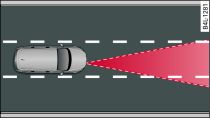
- Fig. 1 Diagram: Area covered by radar sensor
Applies to vehicles: with adaptive cruise control
Vehicles in front are detected by a radar sensor.
The adaptive cruise control uses a radar sensor Fig. 1 which is integrated in the front of the vehicle and is subject to certain system limitations Link. Stationary objects are disregarded. The system requires reflecting surfaces in order to be able to measure the distance. The system initiates a response after measuring the distance. If the system is unable to measure the distance it will not respond.
No vehicle in front
When there is no vehicle in front, the adaptive cruise control works like a speed control system. It maintains a constant target speed specified by the driver.
Vehicle in front
If you catch up with a vehicle driving in front, adaptive cruise control will reduce the speed accordingly (within the limits set by the system Link and Link) and adapt it to the speed of the vehicle in front. Then the system will try to adjust the distance to the car in front according to the settings selected. During the adjustment process the system may temporarily not be able to adhere to the distance you had specified WARNING!.
If the vehicle in front accelerates, the adaptive cruise control will also accelerate, up to the target speed you have specified.
If the vehicle in front stops, e.g. due to stop-go traffic, your vehicle will slow to a standstill (if this is possible within the system limitations) and the text message ACC off: manual control! will appear in the instrument cluster display. In this case, you must press the brake pedal to prevent the vehicle from rolling away. When the vehicle in front starts moving again, you can reactivate the control Link once your vehicle has reached a speed of 2 km/h.
Driver intervention prompt
In some situations, it is necessary for the driver to brake the vehicle with the foot brake in order to keep a safe distance to the vehicle in front or to avoid a collision. In this case, a warning message will appear in the display and you will also hear a warning tone Link.
When overtaking
When you move into the overtaking lane and no vehicle is detected in front, the adaptive cruise control will accelerate up to the target speed and then maintain it.
Overriding
You can still use the accelerator pedal at any time to increase speed in the normal way. The previously programmed speed will be resumed when the accelerator pedal is released.
WARNING!
The brake pedal is automatically drawn in when the adaptive cruise control initiates a braking manoeuvre. Any obstructions that restrict pedal travel can cause loss of vehicle control and critical situations on the road.
- Never place objects in the driver's footwell. Such objects could move under the pedals and interfere with their proper function. In the event of sudden braking or a change of direction, you would not be able to use the pedals. This could result in a loss of control and possibly cause an accident.
- Only use floor mats which leave the pedal area free and can be securely fastened in the footwell (risk of accident).
- Do not rest your foot underneath the brake pedal (risk of accident).
Note
- Please note that acceleration will vary depending on the preset programme. If you have, for example, selected "Distance 1" and the driving programme "dynamic", acceleration will be more "sporty". However, if you have set the system to "Distance 4" and driving programme "comfort", acceleration will be more gradual. For a detailed description please refer to Link.
- No vehicle in front, Vehicle in front and a Driver intervention prompt will be indicated by an indicator lamp in the speedometer Link.
